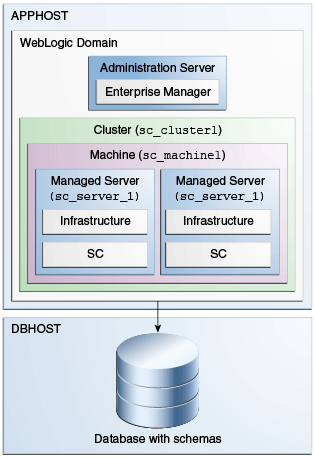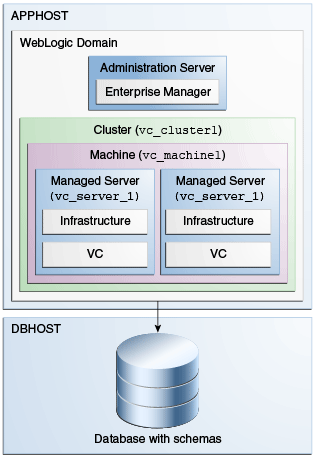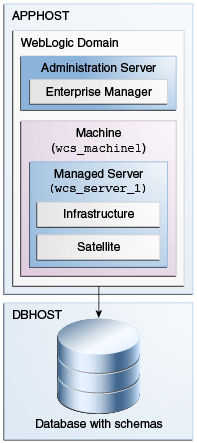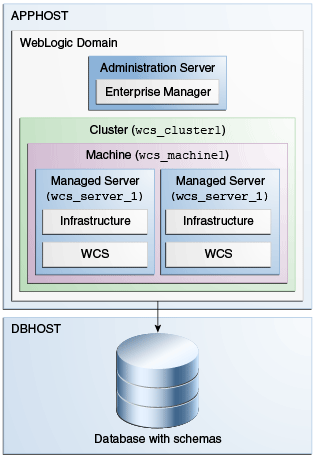1 Understanding Oracle WebCenter Sites Installation
Review the topics thoroughly to ensure that you do not encounter problems during or after installing the product or configuring the domain.
- Using the Standard Installation Topology as a Starting Point
The standard installation topology is a flexible topology that you can use in production environments. - Using This Document to Extend an Existing Domain
The procedures in this document describe how to create a new domain. The assumption is that no other Oracle Fusion Middleware products are installed on your system.
1.1 Using the Standard Installation Topology as a Starting Point
The standard installation topology is a flexible topology that you can use in production environments.
The information in this guide helps you to create a standard installation topology for Oracle WebCenter Sites. You can later extend the standard installation topology to create a secure and highly available production environment.
The standard installation topology represents a sample topology for this product. It is not the only topology this product supports. For more information, see Understanding the Standard Installation Topology in Planning an Installation of Oracle Fusion Middleware.
- Understanding the WebCenter Sites Standard Installation Topology
This topology represents a standard WebLogic Server domain that contains an Administration Server and a cluster containing two Managed Servers. - Understanding Elements in the Standard Installation Topology Illustration
The standard installation topology typically includes common elements. - Understanding the Oracle WebCenter Sites: Insights Standard Installation Topology
- Understanding the Oracle WebCenter Sites: Site Capture Standard Installation Topology
- Understanding the Oracle WebCenter Sites: Visitor Services Standard Installation Topology
- About Oracle WebCenter Sites: Satellite Server Standalone Topology
Oracle WebCenter Sites ships with a copy of Oracle WebCenter Sites: Satellite Server that installs and automatically enables on the same machine as Oracle WebCenter Sites software. This is your co-resident Satellite Server. It gives development and management systems the ability to simulate page delivery as it occurs on the active site (delivery system).
1.1.1 Understanding the WebCenter Sites Standard Installation Topology
This topology represents a standard WebLogic Server domain that contains an Administration Server and a cluster containing two Managed Servers.
The following figure shows the standard installation topology for WebCenter Sites.
See Table 1-1 for information on elements of this topology.
1.1.2 Understanding Elements in the Standard Installation Topology Illustration
The standard installation topology typically includes common elements.
The following table describes all elements of the topology illustration:
Table 1-1 Description of Elements in Standard Installation Topologies
| Element | Description and Links to Related Documentation |
| APPHOST | A standard term used in Oracle documentation to refer to the machine that hosts the application tier. |
| DBHOST | A standard term used in Oracle documentation to refer to the machine that hosts the database. |
| WebLogic Domain | A logically related group of Java components (in this case, the Administration Server, Managed Servers, and other related software components).
For more information, see What is an Oracle WebLogic Server Domain? in Understanding Oracle Fusion Middleware. |
| Administration Server | Central control entity of a WebLogic domain. It maintains configuration objects for that domain and distributes configuration changes to Managed Servers.
For more information, see What is the Administration Server? in Understanding Oracle Fusion Middleware. |
| Enterprise Manager | The Oracle Enterprise Manager Fusion Middleware Control is a primary tool used to manage a domain.
For more information, see Oracle Enterprise Manager Fusion Middleware Control in Understanding Oracle Fusion Middleware. |
| Cluster | A collection of multiple WebLogic Server instances running simultaneously and working together.
For more information, see Understanding Managed Servers and Managed Server Clusters in Understanding Oracle Fusion Middleware. |
| Machine | A logical representation of the computer that hosts one or more WebLogic Server instances (servers). Machines are also the logical glue between the Managed Servers and the Node Manager. In order to start or stop the Managed Servers using the Node Manager, associate the Managed Servers with a machine. |
| Managed Server | A host for your applications, application components, web services, and their associated resources.
For more information, see Understanding Managed Servers and Managed Server Clusters in Understanding Oracle Fusion Middleware. |
| Infrastructure | Collection of services that include the following:
|
1.1.3 Understanding the Oracle WebCenter Sites: Insights Standard Installation Topology
Figure 1-1 shows the standard installation topology for Oracle WebCenter Sites: Insights.
See Table 1-1 for information on elements of this topology.
Figure 1-1 Standard Installation Topology for Oracle WebCenter Sites: Insights

1.1.4 Understanding the Oracle WebCenter Sites: Site Capture Standard Installation Topology
Figure 1-2 shows the standard installation topology for Oracle WebCenter Sites: Site Capture.
See Table 1-1 for information on elements of this topology.
Figure 1-2 Standard Installation Topology for Oracle WebCenter Sites: Site Capture

Description of "Figure 1-2 Standard Installation Topology for Oracle WebCenter Sites: Site Capture "
1.1.5 Understanding the Oracle WebCenter Sites: Visitor Services Standard Installation Topology
Figure 1-3 shows the standard installation topology for Oracle WebCenter Sites: Visitor Services.
See Table 1-1 for information on elements of this topology.
Figure 1-3 Standard Installation Topology for Oracle WebCenter Sites: Visitor Services

1.1.6 About Oracle WebCenter Sites: Satellite Server Standalone Topology
Oracle WebCenter Sites ships with a copy of Oracle WebCenter Sites: Satellite Server that installs and automatically enables on the same machine as Oracle WebCenter Sites software. This is your co-resident Satellite Server. It gives development and management systems the ability to simulate page delivery as it occurs on the active site (delivery system).
The following figure shows the topology for a Satellite Server co-resident installation. For more information on Satellite Server, see Caching to Optimize Performance in Developing with Oracle WebCenter Sites.

1.2 Using This Document to Extend an Existing Domain
The procedures in this document describe how to create a new domain. The assumption is that no other Oracle Fusion Middleware products are installed on your system.
If you have installed and configured other Oracle Fusion Middleware products on your system (for example, Fusion Middleware Infrastructure, with a domain that is up and running), use the same instructions to extend your existing domain. If you choose extend an existing domain, read Installing Multiple Products in the Same Domain in Planning an Installation of Oracle Fusion Middleware for detailed information.
